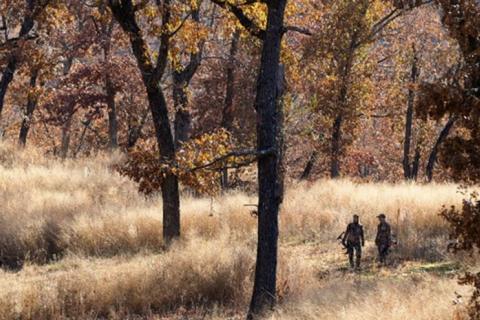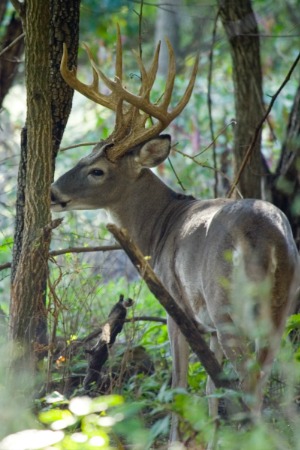
When the lawyer handed us the deed, our dream became a reality. My wife, Becky, and I had worked hard, saved, and finally bought 117 acres to live on. Best of all, 80 acres of it was big, mature woods with towering oaks. This would be our deer hunting paradise.
Funny thing was, the best deer hunting turned out to be in the 30-odd acres of lowland brush, cedars, and fallow fields that were also part of the property. As is often the case, our tall timber held only a few deer—save for a few weeks when the acorns fell.
I felt lucky to have the semi-open lowlands to provide venison in those early years. But over the two decades we’ve owned our land, I’ve undertaken a number of projects that have made finding a buck in the forested acreage just as likely now as in the lowlands. Here are five projects you can undertake to turn you woods into a deer hunting paradise:
1. Create an Area Where Deer Can Find Warmth
To keep deer on your land during inclement weather, you need a thermal refuge. Deer need a place to escape the brutal blasts of winter when snow, sleet and bitter winds blow in.
Locate a spot close to the center of your land, about one to three acres in size. A location that is sheltered from prevailing winds is ideal. First, fell 10 to 30 low-value, small trees. Leave some of them hinge-cut so they tip over but remain alive. Next, plant conifers between the cut trees. The downed timber creates wind blocks, while the evergreens provide thermal protection from cold, snow, and ice.
2. Allow Natural Deer Food to Grow
If you’re lucky, your forest isn’t entirely mature hardwoods. Openings and edges may allow natural deer sustenance like greenbrier, raspberry, honeysuckle and plum to grow. You can power-charge these and improve their ability to draw deer with a few quick steps.
First, if other trees are shading these plants, cut them back so they get more sun. If grapevines, honeysuckle, and other climbing foods are growing over five feet high, they’re out of the reach of most deer. Pull the vine down where whitetails can reach it or cut it back so it grows closer to the ground. Check the pH balance of the soil surrounding the plants. If it is less than six add lime to maximize plant production. The addition of a 10-10-10 fertilizer around each bush will also increase plant size.

3. Create a Transition Zone for Deer
Most woods end abruptly when they join open areas. This keeps wary, mature bucks from approaching fields until after dark. Create a transition zone or staging area between woods and fields where deer can feel comfortable during shooting light.
Do this by cutting down some low-value trees, hinge-cutting others, and planting shrubs between them. Create an area 25 to 50 yards wide where there’s cover that entices deer to the edge of the fields during shooting light. Good shrubs to plant include raspberry, honeysuckle, and Chickasaw Plum.
4. Deer Love to Eat Sweet Fruit
Everyone loves sweets. Give deer a treat by planting fruit trees. At least five hours of sunlight are required, so find open areas such as natural clearings, log landings, or power line openings. Plant at least six trees in each location so they are able to cross pollinate.
I’ve tried many species but the four I’ve had the most luck with are apples, pears, persimmons and plums. Try to plant some early- and late-maturing varieties. Deer relish these fruits and will also nibble on the twigs. If possible, put tree shelters around them so they don’t get damaged by the deer before they’re established.
5. Offer Deer a Snack and Create Food Plots
Sure, your best food plots for deer will be in fields, but you can dramatically improve your timber with the addition of smaller hidden food plots. Top spots to consider are log landings, natural clearings, and logging roads.
Before planting, you will need to clear rocks, leaves, and debris. Most plots need at least four hours of sunlight, so cut back the trees along the edges if necessary. Till the soil with an ATV and disc or rough it up with a garden rake. Kill weeds with glyphosate and add lime or fertilizer as necessary.
Plant a seed blend that thrives with just a small amount of sunlight, such as Whitetail Institute’s Secret Spot or Biologic’s Hot Spot. Make sure the mix includes plants such as crimson clover, arrowleaf clover, brassicas, wheat, oats, buckwheat, and rye. Tamp the seed down by riding over it with your ATV to ensure good seed-to-soil contact. Deer will nibble on these plots during midday and on their way to evening feed spots, offering great bow hunting setups.
Through projects such as these, I can honestly say my woods are now just as likely to produce a mature buck as the more open lowlands. With some toil and sweat you can accomplish the same results on your piece of deer hunting heaven.
Tip: 6 Secrets to Steering Deer to Your Stand
What are you waiting for? Grab the chain saw, crank up the ATV, and hit the woods!
- 28289 views

